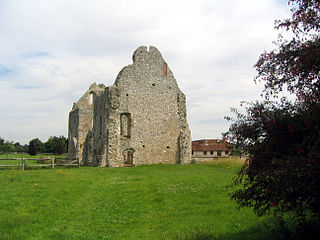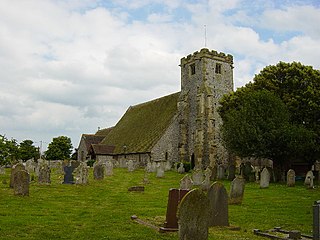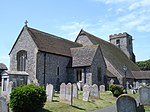
The Kingdom of the South Saxons, today referred to as the Kingdom of Sussex, was one of the seven traditional kingdoms of the Heptarchy of Anglo-Saxon England. On the south coast of the island of Great Britain, it was originally a sixth-century Saxon colony and later an independent kingdom. The kingdom remains one of the least known of the Anglo-Saxon polities, with no surviving king-list, several local rulers and less centralisation than other Anglo-Saxon kingdoms. The South Saxons were ruled by the kings of Sussex until the country was annexed by Wessex, probably in 827, in the aftermath of the Battle of Ellendun.

Boxgrove Priory is a ruined priory in the village of Boxgrove in Sussex, England. It was founded in the 12th century.

Breedon on the Hill is a village and civil parish about 5 miles (8 km) north of Ashby-de-la-Zouch in North West Leicestershire, England. The parish adjoins the Derbyshire county boundary and the village is only about 2 miles (3 km) south of the Derbyshire town of Melbourne. The 2001 Census recorded a parish population of 958 people in 404 households. The parish includes the hamlets of Tonge 1 mile (1.6 km) east of the village and Wilson 1.3 miles (2 km) north of the village on the county boundary. The population at the 2011 census was 1,029 in 450 households.

Lyminster is a village that is the main settlement of Lyminster and Crossbush civil parish, in the Arun District of West Sussex, England. It borders, to the south, Littlehampton, which has its town centre 2 miles (3 km) away.

The Slayer's Slab is a title given to a medieval gravestone formerly in the graveyard of Lyminster church in West Sussex, England. It has now been moved inside the church to protect it from weathering. According to legend it is the gravestone of the dragonslayer who killed the Knucker who lived in the nearby knuckerhole. The stone has a cross on it overlaying a herringbone pattern, but no inscription to identify the tomb's occupant.

Bermondsey Abbey was an English Benedictine monastery. Most widely known as being founded in the 11th century, it had a precursor mentioned in the early eighth century, and was centred on what is now Bermondsey Square, the site of Bermondsey Market, Bermondsey, in the London Borough of Southwark, southeast London, England.

Lewes Priory is a part-demolished medieval Cluniac priory in Lewes, East Sussex in the United Kingdom. The ruins have been designated a Grade I listed building.
Walter Hindes Godfrey, CBE, FSA, FRIBA (1881–1961), was an English architect, antiquary, and architectural and topographical historian. He was also a landscape architect and designer, and an accomplished draftsman and illustrator. He was (1941–60) the first director and the inspiration behind the foundation of the National Buildings Record, the basis of today's Historic England Archive, and edited or contributed to numerous volumes of the Survey of London. He devised a system of Service Heraldry for recording service in the European War.

Hardham is a small village and former civil parish, now in the parish of Coldwaltham, in the Horsham district of West Sussex, England. It is on the A29 road 1.2 miles (2 km) southwest of Pulborough. In 1931 the parish had a population of 107.

50.83673°N 0.55756°W
Worthing Rural District was a rural district in West Sussex, England from 1933 to 1974. It comprised an area to the north, west and east, but did not include the borough of Worthing. Its area encompassed the land in southern Sussex between the Rivers Adur and Arun, with the exception of Arundel, Littlehampton and Worthing itself. The rural district had its council offices at 15 Mill Road, West Worthing, Worthing.
Philip Mainwaring Johnstonfsafriba (1865–1936), also known as PM Johnston, was a British architect and architectural historian.
Ackhampstead or 'The Moor' was an ancient township in the Chiltern Hills, south of Lane End.

Bullington Priory was a priory in Bullington, Lincolnshire, England.

St Mary Magdalene was a Benedictine priory in Lincoln, England. Along with Sandtoft Priory and Hanes Cell, it was a Lincolnshire cell of St Mary's Abbey in York, England. A surviving building, once owned by the priory, is Monks' Abbey, Lincoln.
Arundel Blackfriars, otherwise Dominican Priory, Arundel, was a friary of the Dominican Order in Arundel, West Sussex, England. The date of foundation was before 1253, when Saint Richard, bishop of Chichester, mentioned it in his will. The friary remained small and poor throughout its history. It was dissolved in 1538.
The history of Christianity in Sussex includes all aspects of the Christianity in the region that is now Sussex from its introduction to the present day. Christianity is the most commonly practised religion in Sussex.











